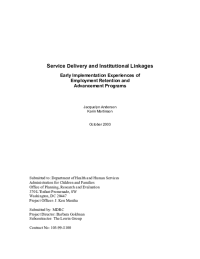Service Delivery and Institutional Linkages
Early Implementation Experiences of Employment Retention and Advancement Programs
Considerable interest exists among state and local welfare departments, workforce investment agencies, community colleges, and other nonprofit community-based service providers to find ways to promote job retention and advancement among employed welfare recipients and other low-wage working families. Little is known, however, about what services are effective. The Employment Retention and Advancement (ERA) evaluation, designed to provide more information about what works in this area, is the largest and most comprehensive study of its kind.
Conceived and sponsored by the Administration for Children and Families (ACF) in the U.S. Department of Health and Human Services (HHS), the evaluation is being conducted under contract by MDRC, a nonprofit, nonpartisan social policy research organization. The U.S. Department of Labor (DOL) has provided additional funding for the project. As of December 2002, a total of 15 ERA programs are being tested in 8 states. This report describes the initial experiences of those programs, focusing on implementation issues and institutional connections.
Key Findings
- Increasing participation in postemployment services. Based on early program assessments, the ERA sites have been fairly successful in contacting and initially engaging participants. Most sites have been able to generate at least one postemployment contact with 70 percent to 80 percent of the people assigned to the ERA program. Encouraging participation in ongoing program activities, however, has been more difficult: In many of the sites, less than half of the employed program group members participated in ongoing activities. To encourage participation, many sites designed creative marketing strategies, and some use financial and in-kind incentives.
- Restructuring retention and advancement services. Because the programs that are designed to increase retention and advancement are so new, staff have found the early phase of the ERA project to be a learning experience; they must understand how to work with participants in a postemployment context. To achieve this, sites have had to create new tools and restructure services. Some have created interview guides and checklists to uncover retention-related issues and explore advancement and training opportunities. Others have trained staff in ways of working with participants (and, in particular, in ways of working with them on advancement issues).
- Creating institutional linkages. Most of the ERA programs use relatively complex organizational arrangements to deliver services. Typically, the programs represent partnerships among several agencies and organizations, including welfare agencies, workforce investment agencies, nonprofit community-based organizations, community colleges, and others; however, at each site, the welfare agency usually takes on the lead organizing role. Rather than forge new relationships for ERA, most programs created partnerships by building on the linkages they had already established for the Temporary Assistance for Needy Families (TANF) program. A key factor in involving the workforce investment system in the ERA program (a linkage that occurred in some sites but not all) is that coordination between workforce investment agencies and welfare agencies is largely driven by funding that flows from the TANF system to the workforce investment system for the purpose of serving welfare recipients or working individuals.
Each ERA program is being evaluated using a research design that assigns people, by chance, either to a program group that receives the new services or to a counterfactual group that receives the services that were available before ERA was developed. MDRC will follow the two groups for three to five years and will produce both site-specific and crosscutting reports that describe the programs and assess their effects.







